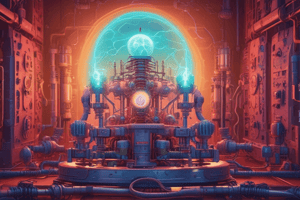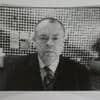Podcast
Questions and Answers
What type of material is most resistant to the flow of electric charge?
What type of material is most resistant to the flow of electric charge?
- Superconductor
- Insulator (correct)
- Semiconductor
- Conductor
What is the relationship between voltage, current, and resistance according to Ohm's Law?
What is the relationship between voltage, current, and resistance according to Ohm's Law?
- Voltage is inversely proportional to current and resistance
- Voltage is directly proportional to current and resistance (correct)
- Voltage is directly proportional to current and inversely proportional to resistance
- Voltage is inversely proportional to current and directly proportional to resistance
What is the unit of measurement for electric power?
What is the unit of measurement for electric power?
- Joule (J)
- Volt (V)
- Watt (W) (correct)
- Ampere (A)
What is the purpose of grounding in electrical systems?
What is the purpose of grounding in electrical systems?
What is the unit of measurement for electric charge?
What is the unit of measurement for electric charge?
Describe the difference between an insulator and a conductor in the context of electrostatic phenomena, and explain how this difference affects the flow of electric charge.
Describe the difference between an insulator and a conductor in the context of electrostatic phenomena, and explain how this difference affects the flow of electric charge.
Explain how the concept of grounding is used to prevent electrical shock in everyday devices, and describe the role of grounding in electrical circuits.
Explain how the concept of grounding is used to prevent electrical shock in everyday devices, and describe the role of grounding in electrical circuits.
Derive the formula for power (P) in terms of voltage (V) and current (I), and explain the physical significance of power in electrical circuits.
Derive the formula for power (P) in terms of voltage (V) and current (I), and explain the physical significance of power in electrical circuits.
Describe the characteristics of a series circuit and a parallel circuit, and explain how these characteristics affect the behavior of resistors in each type of circuit.
Describe the characteristics of a series circuit and a parallel circuit, and explain how these characteristics affect the behavior of resistors in each type of circuit.
Explain the concept of energy efficiency in electrical systems, and describe how it is related to the ratio of output power to input power.
Explain the concept of energy efficiency in electrical systems, and describe how it is related to the ratio of output power to input power.
Flashcards
Electric Current
Electric Current
The flow of electric charge through a conductor.
Electric Circuit
Electric Circuit
A path through which electric current flows, typically composed of a power source, conductors, and a load.
Resistance
Resistance
The opposition to the flow of electric current through a material.
Voltage
Voltage
Signup and view all the flashcards
Ohm's Law
Ohm's Law
Signup and view all the flashcards
Ampere (A)
Ampere (A)
Signup and view all the flashcards
Coulomb (C)
Coulomb (C)
Signup and view all the flashcards
Ohm (Ω)
Ohm (Ω)
Signup and view all the flashcards
Electrostatic Induction
Electrostatic Induction
Signup and view all the flashcards
Conductors
Conductors
Signup and view all the flashcards
Study Notes
Early Models of Charge and Scientists
- Ancient Greeks discovered that rubbing amber against fur could create a static electric charge
- Thales of Miletus (624-546 BCE) first studied electricity
- Benjamin Franklin conducted extensive research on electricity and proposed the concept of positive and negative charges
Types of Charging
- Frictional charging: transfer of electrons between objects through physical contact
- Induction charging: creation of an electric field by bringing a charged object near a neutral object
- Electrostatic induction: transfer of electrons between objects without physical contact
Electrostatic Phenomena
- Like charges repel each other, opposite charges attract each other
- Electrostatic force is a non-contact force
- Coulomb's Law: Force between two charges is inversely proportional to square of distance between them
Insulators and Conductors
- Insulators: materials that resist the flow of electric charge (e.g., glass, wood, plastic)
- Conductors: materials that allow the flow of electric charge (e.g., copper, metal, water)
Grounding
- Grounding: connecting an object to the Earth to discharge electrical energy
- Purpose: to prevent electrical shocks and fires
Sources of Electrical Energy
- Batteries: contain chemical energy converted to electrical energy
- Generators: convert mechanical energy into electrical energy
- Solar panels: convert light energy into electrical energy
Currents and Circuits
- Electric current: flow of electric charge
- Electric circuit: path through which electric current flows
- Series circuits: components connected one after the other
- Parallel circuits: components connected between the same two points
Current and Charge Calculations
- Current (I) = Charge (Q) / Time (t)
- Unit of current: ampere (A)
- Unit of charge: coulomb (C)
Voltage, Charge, Current, Resistance
- Voltage (V): potential difference between two points
- Unit of voltage: volt (V)
- Resistance (R): opposition to electric current flow
- Unit of resistance: ohm (Ω)
Ohm's Law and Calculations
- V = I × R
- I = V / R
- R = V / I
Power, Energy, and Efficiency
- Power (P): rate of energy transfer
- Unit of power: watt (W)
- Energy (E): total work done
- Unit of energy: joule (J)
- Efficiency (η): ratio of output power to input power
Early Models of Charge and Scientists
- Ancient Greeks discovered that rubbing amber against fur could create a static electric charge
- Thales of Miletus (624-546 BCE) first studied electricity
- Benjamin Franklin conducted extensive research on electricity and proposed the concept of positive and negative charges
Types of Charging
- Frictional charging: transfer of electrons between objects through physical contact
- Induction charging: creation of an electric field by bringing a charged object near a neutral object
- Electrostatic induction: transfer of electrons between objects without physical contact
Electrostatic Phenomena
- Like charges repel each other, opposite charges attract each other
- Electrostatic force is a non-contact force
- Coulomb's Law: Force between two charges is inversely proportional to square of distance between them
Insulators and Conductors
- Insulators: materials that resist the flow of electric charge (e.g., glass, wood, plastic)
- Conductors: materials that allow the flow of electric charge (e.g., copper, metal, water)
Grounding
- Grounding: connecting an object to the Earth to discharge electrical energy
- Purpose: to prevent electrical shocks and fires
Sources of Electrical Energy
- Batteries: contain chemical energy converted to electrical energy
- Generators: convert mechanical energy into electrical energy
- Solar panels: convert light energy into electrical energy
Currents and Circuits
- Electric current: flow of electric charge
- Electric circuit: path through which electric current flows
- Series circuits: components connected one after the other
- Parallel circuits: components connected between the same two points
Current and Charge Calculations
- Current (I) = Charge (Q) / Time (t)
- Unit of current: ampere (A)
- Unit of charge: coulomb (C)
Voltage, Charge, Current, Resistance
- Voltage (V): potential difference between two points
- Unit of voltage: volt (V)
- Resistance (R): opposition to electric current flow
- Unit of resistance: ohm (Ω)
Ohm's Law and Calculations
- V = I × R
- I = V / R
- R = V / I
Power, Energy, and Efficiency
- Power (P): rate of energy transfer
- Unit of power: watt (W)
- Energy (E): total work done
- Unit of energy: joule (J)
- Efficiency (η): ratio of output power to input power
Studying That Suits You
Use AI to generate personalized quizzes and flashcards to suit your learning preferences.





